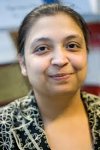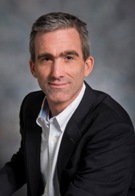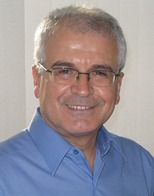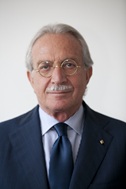Keynote Speakers
 Neeli Prasad
Center for Teleinfrastruktur, Aalborg University, Denmark
Neeli Prasad
Center for Teleinfrastruktur, Aalborg University, Denmark
Neeli Prasad is leading a global team of 20+ researchers across multiple technical areas and projects in Japan, India, throughout Europe and USA. She has a Master of Science degree from Delft University, Netherlands and a PhD degree in electrical and electronic engineering from University of Rome Tor Vergata, Italy. She has been involved in projects totaling more than $120 million – many of which she has been the principal investigator. Her notable accomplishments include enhancing the technology of multinational players including Cisco, HUAWEI, NIKSUN, Nokia-Siemens and NICT as well as defining the reference framework for Future Internet Assembly and being one of the early key contributors to Internet of Things. She is also an advisor to the European Commission and expert member of governmental working groups and cross-continental forums. Previously, she has served as chief architect on large-scale projects from both the network operator and vendor side looking across the entire product and solution portfolio covering wireless, mobility, security, Internet of Things, Machine-to-Machine, eHealth, smart cities and cloud technologies. She has more than 250 publications and published two of the first books on WLAN. She is an IEEE senior member and an IEEE Communications Society Distinguished Lecturer 2013-2014.
Internet of Things (IoT), Machine to Machine (M2M) and enabling technologies
INTERNET-OF-THINGS (IoT) and Machine-to-Machine (M2M) hold the promise of transforming the way in which enterprises do business and how we live our lives. As such, the two topics go across technologies - from the very sensing and actuation all the way to the applications that sit in the cloud — including all the intermediate layers of network communication.
This lecture starts by presenting use cases of IoT and M2M from the already implemented to the smart-cities and -communities. Following this, the state-of-the-art enabling technologies will be presented with a walkthrough of the complete layers and architectures for wireless sensor networks and related technologies such as RFID. Next, end-to-end architectures for enabling the IoT and M2M eco-system are presented. Security, privacy, and trust are of the utmost importance in any scenario including personal or sensitive data or information and are present as a separate topic.
 Edward Knightly
Departament Chair
Electrical and Computer Engineering
Rice University, Texas
Edward Knightly
Departament Chair
Electrical and Computer Engineering
Rice University, Texas
Edward Knightly is a professor and the department chair of Electrical and Computer Engineering at Rice University in Houston, Texas. He received his Ph.D. and M.S. from the University of California at Berkeley and his B.S. from Auburn University. He is an IEEE Fellow, a Sloan Fellow, and a recipient of the National Science Foundation CAREER Award. He received the best paper award from ACM MobiCom 2008 and serves on the IMDEA Networks Scientific Council.
Professor Knightly’s research interests are in the areas of mobile and wireless networks with a focus on protocol design, performance evaluation, and at-scale field trials. He leads the Rice Networks Group. The group’s current projects include deployment, operation, and management of a large-scale urban wireless network in a Houston under-resourced community. This network, Technology For All (TFA) Wireless, is serving over 4,000 users in several square kilometers and employs custom-built programmable and observable access points. The network is the first to provide residential access in frequencies spanning from unused UHF TV bands to legacy WiFi bands (500 MHz to 5 GHz). His group developed the first multi-user beam-forming WLAN system that demonstrates a key performance feature to be provided by IEEE 802.11ac. His group also co-developed a clean-slate-design hardware platform for high-performance wireless networks, TAPs and WARP.
WiFi in sub-GHz Bands: Research Advances and Global Trials
Worldwide, spectrum regulators are repurposing spectrum and introducing new frameworks for spectrum sharing. In this talk, I will describe new standards, prototypes, and research advances exploiting new spectrum bands. I will focus on the unique characteristics of bands below 1 GHz, often termed the "beach front property" of spectrum due to their superior range and penetration capabilities compared to existing WiFi bands. I will draw on experiences from trials in Houston, Texas and Itaipu, Brazil and will describe emerging global opportunities.
 Hikmet Sari
Department Head
SUPÉLEC, France
Hikmet Sari
Department Head
SUPÉLEC, France
Hikmet Sari is a Professor and Head of the Telecommunications Department at SUPELEC, France, and Chief Scientist of Sequans Communications. Previously, he held research and management positions at Philips, SAT, Alcatel, Pacific Broadband Communications, and Juniper Networks. He received his Engineering Diploma and Ph.D. from the ENST, Paris, France, and the Habilitation degree from the University of Paris-Sud, Orsay.
Dr. Sari has served as an Editor of the IEEE Transactions on Communications, Guest Editor of the European Transactions on Telecommunications, Guest Editor of IEEE JSAC, Associate Editor of the IEEE Communications Letters, Chair of the Communication Theory Symposium of ICC 2002, Technical Program Chair of ICC 2004, Vice General Chair of ICC 2006, General Chair of PIMRC 2010, General Chair of WCNC 2012, Chair of the GITC Committee in 2010 – 2011, Distinguished Lecturer of the IEEE Communications Society (2001 - 2006), Member of the IEEE Fellow Evaluation Committee (2002 - 2007), and Member of the Awards Committee (2005 – 2007) of this society. He is currently serving as Executive Chair of WCNC 2014, Executive Vice-Chair of ICC 2016, Executive Chair of ICC 2017, and Vice-President – Conferences of the IEEE Communications Society for 2014 – 2015.
His distinctions include the IEEE Fellow Grade and the Andre Blondel Medal in 1995, the Edwin H. Armstrong Award in 2003, the Harold Sobol Award in 2012, and election to the European Academy and to the Science Academy of Turkey in 2012.
Multiple Access and Power Efficiency in Wireless Communications
In this talk, we will first give a brief review of some major advances in multicarrier transmission and multiple access techniques, which shaped the development of the wireless communications standards that came into existence over the past decade. The review includes the development of OFDM and single-carrier transmission with frequency-domain equalization (SC-FDE) as well as the birth of OFDMA and of single-carrier FDMA (SC-FDMA), which were adopted by the Mobile WiMAX and the 3GPP LTE standards. We report the results of a comparison between OFDMA and SC-FDMA on a linear channel using different code rates in the channel encoder. Next, we address the nonlinear distortion problems caused by the high-power amplifier (HPA) at the transmitter in wireless communications systems and describe the various techniques devised to compensate for this phenomenon in single-carrier and multicarrier transmission. We emphasize the fact that the optimum operating point of the power amplifier cannot be always achieved in practice due to the stringent spectral masks imposed. We describe ideal signal predistortion that is applicable to both single-carrier and multicarrier systems and then we discuss peak-to-average power ratio (PAPR) reduction for multicarrier systems. We point out a recent result that the gain achieved in terms of PAPR does not translate in terms of transmitted signal power for a given power amplifier.
 Maurizio Dècina
Professor
Politecnico di Milano, Italy
Maurizio Dècina
Professor
Politecnico di Milano, Italy
Maurizio Dècina is Emeritus Professor of the Politecnico di Milano, Italy. He equally shared his 45-year career in telecommunications between industry and university. He was scientific consultant for AT&T Bell Laboratories in Chicago, scientific Director and founder of the CEFRIEL consortium, and Executive R&D Director of Italtel in Milan. Prof. Dècina was a Commissioner of the Italian Communications Authority, AGCOM, President of the Ugo Bordoni Foundation, and Member of the Board of Telecom Italia, Italtel and several ICT Companies. Prof. Dècina was President of the IEEE Communications Society. IEEE appointed him Life Fellow for contributions to voice/data packet switching, and he received three IEEE Awards: International Communications, Third Millennium Medal, and ComSoc/KICS Global Service.
Future of Networks
Twenty years ago, Internet and cellular radio networks were at their infancy, while today they are pervasive all over the planet. Twenty years from now, disruptive technologies are going to affect wired and wireless networks and their business models. In 2035, optical fiber technology for access and backhauling will offer capacities reaching the theoretical limit of 500 Tbit/s per mono-mode fiber. The pervasive fiber infrastructure will be instrumental to achieve on the wide areas the stringent delays required by cloud computing and by critical service applications (vehicular traffic control, smart grid, disaster recovery, etc.). In 2035, wireless networks will be heterogeneous, with a variety of cell sizes and relays, as well as a variety of radio frequencies, interfaces and processing styles, such as cognitive radio. 5G/6G cellular systems will be widely deployed to cope with these requirements and to incorporate new features to support machine-to-machine and device-to-device communications. To cope with heterogeneity, cloud computing will provide suitable solutions by offering a wide range of virtualization functions for radio and communications protocols, as well as for specific network devices. Software defined networks will be widely deployed by 2035: new business and regulatory models should arise to reshape the market of telecommunication manufacturing and services, including the role of the “over the top” service providers. In 2035, the Internet of things will not comprise just smart objects, but also a huge amount of computing resources, such as web pages and widgets. The framework of naming things/caches and providing security and authentication in the Web of Things is a challenging issue that opens the way for a new Internet architecture based on names and content, rather than on IP addresses. Service centric networking should also be instrumental to provide novel frameworks for efficient mobility management.